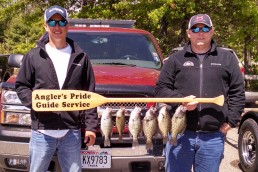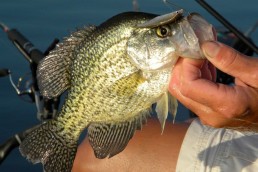Go ‘On Point’ for Crappies in October
SHARE THIS POST
Bass fishermen are famous for hopping from point to point. Bass go to these locations for its advantages late in the season, but so do the crappies. A point can be short, long, narrow, wide, deep or shallow, while its bottom can be mud, rock, weeds, gravel or a combination. It can also contain drop-offs, cover or current, and these features can vary.
Kevin Jones is a tournament fisherman from Missouri and a pro staffer on the team of Missouri Corn Growers Association/ American Ethanol.
“My favorite time to fish points is probably in the spring, but they can be good any time including the fall and winter,” Jones said. “In the fall the crappies are chasing shad, so points are good places to look for both crappies and baitfish. Start your search in the mid-depths and work shallow or deep from there.”
When Jones heads to a new lake he is looking for drop-offs, points and other key structures where fish are holding. A paper or electronic map shows the points, but can also show contours, drops, turns, dips and nearby channels related to the chosen point. He added that the experience of knowing crappie movement for the season helps you choose the best spots. But only by scanning with electronics and going out and fishing will one learn the best points and specific spots related to the points.
These areas are also productive because there are depth changes. The crappies are a depth-oriented species, so they’ll be at the same general depth across a lake. A point gives them the opportunity to be at their desired depth without traveling to a different structure. When the depth, contour, cover and current match their best preference, it’s a crappie goldmine.
Fast attack
When crappies are chasing shad in fall, a fast technique is an advantage. Fast trolling, or longlining, allows you to cover a lot of water. A point can be worked at a specific depth or quickly fished at multiple depths to find the fish.
Fast trolling is a simple technique where baits are casted out the back of the boat and pulled through the water. Speeds of 0.7 to 1.2 mph are typical. Bait depth is determined primarily by speed, line length and jig weight. For example, consider 1/16-ounce jigs and a line length of 40 feet from a rod tip. Adjusting the trolling motor speed helps control the jig depths. Multiple poles provide a wide coverage and allow different-colored jigs to be used.
Are you enjoying this post?
You can be among the first to get the latest info on where to go, what to use and how to use it!
The ideal situation would be to find a point with cover, lots of shad and crappies relating to it, but not tight to the cover. By trolling baits over the cover you can target these feeding crappies. Obviously, keeping baits out of the cover is important when fast trolling.
Slow-trolling
Jones believes slow-trolling is the best way to catch numbers of big fish. This method makes it easy to follow schools of shad or to target specific covers and stop the baits where they are. He varies speeds from around 0.5 mph to a full stop based upon what the fish are doing and how they are relating to the structure.
The multiple-bait attack with long poles positioned at the front of the boat gives precision control. Jones says catching fish is all about bait control. Baits can be put into a stake bed or pushed along the side of a point. He says trolling is probably the best technique the weekend fisherman can learn.
For crappies in a tight point in a river, Jones says that the current there can mean good or terrible fishing, and that it can change quickly. But he adds that light penetration is important and can cause crappies to move up or down, so pay attention to factors and adjust, even your equipment.
“When I’m using a jig, I like a big hook—bigger than what most standard jigs come with,” Jones said. “I use a number 1 hook, whether fishing 1/4 or 1/32 ounce, or something in between. I’ll usually fish a large body bait like a Muddy Water and tip it with a minnow. I don’t hesitate modifying a bait color, length, the way I hook it or anything else, to get a crappie to bite. I believe fish have favorite colors in different lakes, but offering something a little different than what other fishermen are using can be a big advantage.”
Points are ideal places to intercept the late-season crappies. You can enjoy chasing your big buck deer this month, but don’t forget that hungry crappies are out there waiting to give you some good action.
MWO
SHARE THIS POST
Did you enjoy this post?
You can be among the first to get the latest info on where to go, what to use and how to use it!
Tim Huffman
Tim Huffman specializes in crappie fishing, is editor for two crappie magazines, as well as writing for several others. In 2018, he published his sixth book, Limiting Out for Crappie, available at Amazon. His first article appeared in MidWest Outdoors in 1988.



